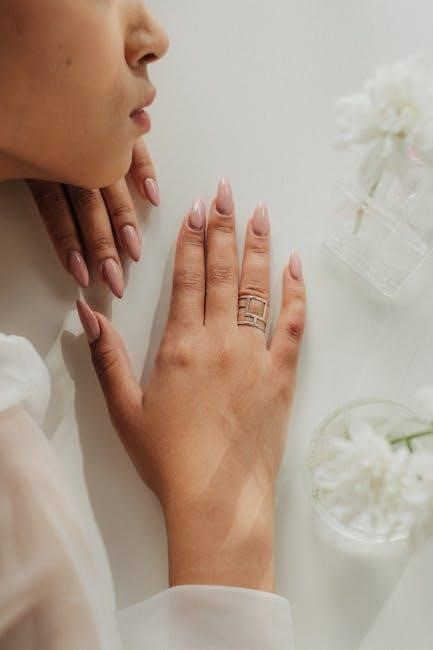
Nail Biting: A Comprehensive Guide
Welcome to this comprehensive guide that helps you understand and overcome nail biting. We will explore the causes, consequences, and effective strategies to break this common habit for healthier nails and improved well-being.
Understanding Nail Biting
Nail biting, also known as onychophagia, is a prevalent habit characterized by the repetitive act of biting one’s fingernails. It is often classified as a body-focused repetitive behavior (BFRB), falling under a spectrum of habits that includes skin picking, hair pulling, and teeth grinding.
This seemingly innocuous habit affects individuals of all ages, genders, and backgrounds, but is most commonly observed in children and adolescents. While often dismissed as a mere nervous tic, nail biting can have significant physical, psychological, and social implications for those who engage in it chronically.
Understanding the nuances of nail biting requires recognizing that it is rarely a conscious decision. It often occurs automatically, triggered by stress, boredom, anxiety, or even periods of intense concentration. Many individuals are unaware they are even biting their nails until they notice the damage or someone points it out.
This lack of awareness is a key component of why breaking the habit can be challenging. It’s not simply a matter of willpower or telling oneself to stop. Instead, it requires a deeper understanding of the underlying triggers and motivations that drive the behavior, as well as the implementation of targeted strategies to interrupt the cycle.

Furthermore, nail biting exists on a spectrum of severity. Some individuals may only bite their nails occasionally, while others engage in the habit compulsively, leading to significant damage and distress. Recognizing the severity of the habit is crucial for determining the appropriate course of action and seeking professional help when necessary.
Why Do People Bite Their Nails?
The reasons behind nail biting are multifaceted, stemming from a complex interplay of psychological, environmental, and even genetic factors. While there isn’t one single cause that applies to everyone, several common themes emerge when exploring the motivations behind this behavior.
One of the primary drivers of nail biting is stress and anxiety. For many, the act of biting their nails serves as a coping mechanism, providing a temporary sense of relief or distraction from overwhelming feelings. The physical sensation can be grounding, offering a momentary escape from anxious thoughts or stressful situations. This can become a learned association, where nail biting is subconsciously linked to stress reduction.
Boredom is another frequent trigger. When faced with monotonous tasks or periods of inactivity, individuals may turn to nail biting as a way to occupy their hands and minds. The repetitive nature of the behavior can provide a form of stimulation, alleviating the discomfort of boredom.

Habit and learned behavior also play a significant role. Nail biting often begins in childhood, and over time, it can become an ingrained habit that is difficult to break. This is especially true if the behavior has been reinforced by positive associations, such as the aforementioned stress relief or boredom alleviation.
Furthermore, some research suggests a possible genetic predisposition to body-focused repetitive behaviors like nail biting. Individuals with a family history of such behaviors may be more likely to develop them themselves. Perfectionism and a tendency towards nervous habits can also increase the likelihood of nail biting.
The Psychological Factors
Nail biting is often deeply intertwined with various psychological factors, extending beyond mere habit. Understanding these underlying mental and emotional states is crucial in addressing the root causes of the behavior and developing effective strategies to overcome it.
Anxiety is a significant contributor. Individuals experiencing generalized anxiety disorder, social anxiety, or panic disorder may use nail biting as a way to manage their anxious feelings. The act can provide a sense of control and predictability in moments of uncertainty or fear.
Stress, whether chronic or acute, also plays a major role. Nail biting can serve as a release valve for pent-up tension and frustration. The physical sensation may offer a temporary distraction from stressful thoughts and worries, providing a brief respite from overwhelming pressure.
Perfectionism is another psychological trait often associated with nail biting. Individuals with perfectionistic tendencies may be more prone to anxiety and self-criticism, which can trigger the behavior. The act of biting nails may be a form of self-punishment or a way to cope with feelings of inadequacy.
Low self-esteem can also contribute to nail biting. Individuals who lack confidence or have a negative self-image may engage in the behavior as a form of self-soothing or self-harm. The act can provide a temporary sense of comfort or distraction from feelings of worthlessness.
Finally, obsessive-compulsive tendencies can be linked to nail biting. While not everyone who bites their nails has OCD, the repetitive and compulsive nature of the behavior can share similarities with obsessive-compulsive behaviors.
The Physical Consequences of Nail Biting
Nail biting, while often perceived as a harmless habit, can lead to a range of significant physical consequences that affect not only the appearance of the nails but also overall health. Understanding these potential health risks is crucial for motivating individuals to break the habit.
One of the most visible consequences is damage to the nails themselves. Chronic nail biting can result in shortened, misshapen, and brittle nails. The nail bed can become damaged, leading to permanent deformities. The cuticles, which protect the nail matrix, are also vulnerable, leading to inflammation and infection.
The skin surrounding the nails is also susceptible to damage. Constant biting and picking can cause redness, swelling, and pain. Open wounds can develop, creating entry points for bacteria and fungi, increasing the risk of infections like paronychia, a painful infection around the nail.

Nail biting significantly increases the risk of various infections. The mouth is teeming with bacteria, and transferring these microorganisms to the damaged skin around the nails can lead to bacterial infections. Conversely, bacteria and viruses from under the nails can be transferred to the mouth, potentially causing illnesses.
Dental problems are another potential consequence. The constant gnawing on nails can wear down tooth enamel, leading to increased sensitivity and an elevated risk of cavities. Nail biting can also interfere with proper dental alignment, potentially causing jaw pain and temporomandibular joint (TMJ) disorders.
Finally, in severe cases, chronic nail biting can lead to ingrown nails. This painful condition occurs when the nail grows into the surrounding skin, often requiring medical intervention.
Damage to Nails and Skin
The persistent act of biting nails inflicts considerable damage on both the nails themselves and the surrounding skin. This damage ranges from minor cosmetic issues to more severe physical problems. Understanding the extent of this harm is a key step in motivating individuals to quit.
Nails, when subjected to constant biting, often become significantly weakened. They can become brittle, prone to splitting, and develop an uneven, jagged appearance. The nail plate, the hard outer layer of the nail, can be eroded, making the nails thinner and more susceptible to breakage. In severe cases, the nail bed itself can be damaged, leading to permanent nail deformities. This can manifest as ridges, grooves, or an overall distorted shape of the nail.
The skin surrounding the nails, particularly the cuticles, is also highly vulnerable. Biting and picking at the cuticles can lead to inflammation, redness, and swelling. The protective barrier of the cuticle is compromised, making the area more susceptible to infection. Open wounds and sores can develop around the nails, creating entry points for bacteria and fungi.
Chronic nail biting can also result in the formation of hangnails – small, torn pieces of skin that can be painful and unsightly. Picking at hangnails further exacerbates the damage and increases the risk of infection. The skin around the nails may become thickened and calloused due to the repeated trauma.
Furthermore, the constant trauma to the nail and surrounding skin can disrupt the normal nail growth cycle. This can result in slow nail growth, or the development of abnormal nail growth patterns.
Increased Risk of Infection
Nail biting significantly elevates the risk of infections affecting the fingers, nails, and even the mouth. This increased susceptibility stems from the introduction of bacteria, viruses, and fungi into the body through damaged skin and the transfer of germs from the hands to the mouth.
The area around the nails, when bitten, often develops small cuts, tears, and abrasions. These breaks in the skin’s protective barrier provide easy access for pathogens to enter the body. Bacteria, such as Staphylococcus aureus, commonly found on the skin and under the nails, can cause localized infections known as paronychia. Paronychia manifests as redness, swelling, pain, and the formation of pus-filled blisters around the nail.
Fungal infections are also a concern for nail biters. Fungi thrive in moist, dark environments, making the damaged nail bed an ideal breeding ground. Fungal nail infections, or onychomycosis, can cause thickening, discoloration, and crumbling of the nails.
Furthermore, the mouth is teeming with bacteria. When nails are bitten, these bacteria can be transferred to the fingers, increasing the risk of infections in the nail area. Conversely, bacteria and viruses from the hands are introduced into the mouth, potentially leading to oral infections, such as herpes simplex virus (cold sores) or bacterial infections of the gums.
In severe cases, infections from nail biting can spread beyond the immediate area and lead to more serious complications, such as cellulitis, a bacterial infection of the deeper layers of the skin. Individuals with weakened immune systems are particularly vulnerable to these more severe infections.
Dental Problems
Chronic nail biting can contribute to a range of dental problems, impacting the teeth, gums, and jaw. The repetitive pressure and unnatural movements associated with nail biting can exert undue stress on the teeth, leading to several adverse effects.
One common issue is malocclusion, or misalignment of the teeth. The constant pressure from biting nails can gradually shift the teeth out of their proper alignment, leading to bite problems such as overbite, underbite, or crossbite. These misalignments can interfere with chewing, speaking, and even breathing.
Nail biting can also contribute to temporomandibular joint (TMJ) disorders. The TMJ is the joint that connects the jawbone to the skull. The repetitive motions and muscle tension associated with nail biting can strain the TMJ, leading to pain, clicking or popping sounds in the jaw, headaches, and difficulty opening or closing the mouth.
Furthermore, nail biting can damage tooth enamel, the protective outer layer of the teeth. The hard surface of the nails can cause microscopic cracks and chips in the enamel, making the teeth more susceptible to decay and sensitivity. Over time, this enamel erosion can lead to cavities and the need for dental fillings or other restorative treatments.
The gums can also suffer from nail biting. The sharp edges of the nails can irritate and injure the gum tissue, leading to inflammation, bleeding, and recession. Gum recession exposes the roots of the teeth, making them more vulnerable to decay and sensitivity. In severe cases, gum disease (periodontitis) can develop, which can lead to tooth loss.
Breaking the Habit: Strategies and Techniques
Breaking the nail-biting habit requires a multi-faceted approach, combining awareness, behavioral techniques, and consistent effort. It’s crucial to understand that overcoming this habit is a process, and patience and persistence are key.
One of the first steps is to identify your triggers. What situations, emotions, or thoughts tend to lead to nail biting? Keeping a journal to track these triggers can provide valuable insights into the underlying causes of your habit. Once you know your triggers, you can develop strategies to manage them.
Another effective technique is to find a replacement behavior. When you feel the urge to bite your nails, try engaging in a different activity that occupies your hands. This could include squeezing a stress ball, doodling, knitting, or even simply clenching your fists. The goal is to redirect your attention and energy away from your nails.
Making your nails less accessible can also be helpful. Keep your nails trimmed short to minimize the temptation to bite. You can also apply a bitter-tasting nail polish to deter you from putting your fingers in your mouth. Some people find that wearing gloves or bandages on their fingertips can also be an effective physical barrier.
Enlisting the support of friends, family, or a therapist can provide additional motivation and accountability. Sharing your goals with others can help you stay on track and provide you with a support system to turn to when you’re struggling. Remember to celebrate your successes along the way, no matter how small they may seem.
Awareness and Identification
The initial and arguably most crucial step in breaking the nail-biting habit is cultivating awareness. Many individuals bite their nails unconsciously, often without realizing they’re doing it until after the fact. Therefore, the first challenge is to bring this behavior into conscious awareness.
Start by paying close attention to your hands throughout the day. Make a mental note each time you find yourself biting your nails, or even just bringing your fingers to your mouth. Try to identify the situations, emotions, or thoughts that trigger these actions. Are you stressed, bored, anxious, or simply lost in thought?
Keeping a journal can be an extremely helpful tool in this process. Each time you bite your nails, record the date, time, location, and the circumstances surrounding the event. Note your emotional state at the time, as well as any specific thoughts that were running through your head. Over time, patterns will begin to emerge, revealing the underlying triggers for your nail-biting behavior.
Another useful technique is to enlist the help of a friend or family member. Ask them to gently point out when they notice you biting your nails. This can provide an external perspective and help you become more aware of the habit in real-time.
By increasing your awareness of when, where, and why you bite your nails, you can begin to develop strategies to interrupt the behavior and replace it with healthier alternatives. This newfound awareness forms the foundation for all other techniques aimed at breaking the habit.
Behavioral Therapy Techniques
Behavioral therapy offers a range of effective techniques to address nail biting. One cornerstone is Cognitive Behavioral Therapy (CBT), which focuses on identifying and modifying negative thought patterns and behaviors. CBT helps individuals understand the triggers for nail biting and develop coping mechanisms to manage those triggers without resorting to the habit.
Stimulus control is another key technique; This involves modifying the environment to reduce exposure to triggers. For example, if boredom is a trigger, engaging in stimulating activities can help. If anxiety is a trigger, practicing relaxation techniques like deep breathing or meditation can be beneficial.
Another approach involves competing response training. This technique involves replacing nail biting with a different, more acceptable behavior. For instance, when the urge to bite arises, one could clench their fists, squeeze a stress ball, or engage in a fidgeting activity that keeps the hands occupied.
Self-monitoring is also crucial. Keeping a log of nail-biting episodes helps to track progress and identify patterns. This awareness allows for more targeted interventions.
Finally, reinforcement techniques can be employed. Rewarding oneself for abstaining from nail biting, even for short periods, can provide positive reinforcement and encourage continued effort. These behavioral techniques, often used in combination, offer a structured and effective approach to breaking the nail-biting habit.

Seeking Professional Help
Habit Reversal Training
Habit Reversal Training (HRT) is a structured behavioral therapy technique specifically designed to address habits like nail biting. HRT consists of several components working together to increase awareness and control over the unwanted behavior. The first step is awareness training, where individuals learn to identify the specific situations, emotions, and thoughts that precede nail biting.
This heightened awareness is crucial for anticipating and preventing the behavior. Next comes competing response training, where individuals learn to substitute nail biting with a more acceptable and incompatible behavior. This competing response should be something that is easy to perform, socially acceptable, and physically prevents nail biting.
For example, clenching your fists, touching your fingertips to your thumb, or sitting on your hands. The competing response should be practiced regularly, even when the urge to bite is not present, to strengthen the new habit.
Motivation is enhanced through social support and reinforcement. Encouragement from friends, family, or a therapist can be incredibly helpful. Tracking progress and rewarding successes, even small ones, further reinforces the desired behavior change.
HRT also emphasizes generalization training, which involves practicing the competing response in different settings and situations to ensure that the new habit is effective across various contexts. By systematically addressing awareness, response substitution, and motivation, Habit Reversal Training provides a comprehensive and effective approach to overcoming nail biting.